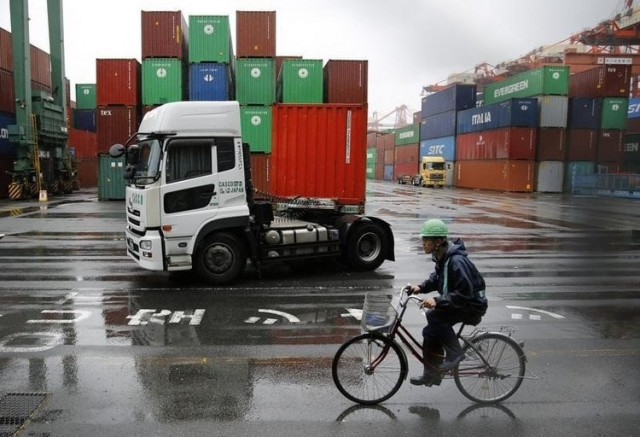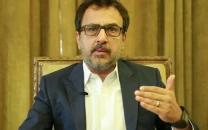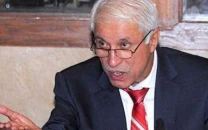Competitiveness only solution to Pakistan’s economic woes
This way country can cash in on the opportunities arising from the BRI

A worker rides a bicycle in a container area at a port. PHOTO: REUTERS
The six corridors that comprise the BRI include New Eurasia Land Bridge, China-Mongolia-Russia, China-Central Asia-West Asia, China-Indochina Peninsula, China-Pakistan and Bangladesh-China-India-Myanmar, which snake through a number of countries. This way, the BRI has attracted cooperation from 144 countries.
China is striving to emerge as a major winner with the sharing of benefits of connectivity and integration. In the past three quarters, there has been a positive trend in China’s trade, which is worth $865 billion, with partner countries of the BRI. The growth in this trade is 3.3% higher than the overall growth rate of China. It seems it will cross last year’s level of $1.1 trillion. Chinese companies are benefiting in a big way by investing in BRI economies, which has reached $10 billion per year.
Keeping in view the massive trade volume, China is devising ways to capitalise on the huge potential for commerce. It organised an international import expo from November 5-10 – a unique event as countries usually organise export expos, but Beijing held an import fair. The exhibition encouraged participating countries to export more to China. The offer was very generous but only those countries would be able to cash in on the opportunity which will be more competitive.
Pakistan’s rankings
Unfortunately, Pakistan is not well placed on the global competitiveness index. It is ranked 115th – a ranking which is even lower than those of Central Asian states like Tajikistan, which has got a ranking of 79, Kazakhstan 57 and Kyrgyzstan 102.
Pakistan’s performance on other indicators is also disappointing like basic requirements, where its rank is 114th, efficiency enhancers (104) and innovation and sophistication (72). The situation is almost similar on the indicators of institutions (90) and infrastructure (110).
Even on these indicators, some Central Asian countries are at higher places than Pakistan. Tajikistan and Kazakhstan stand at 42nd and 60th places respectively on the institutions indicator and on the infrastructure index Kazakhstan, Tajikistan and Kyrgyzstan have 68th, 99th and 109th rankings respectively. Although Pakistan is the 28th largest economy of the world, its competitiveness indicators are very poor.
Exports of Pakistan have not increased, in fact they have gone down, in the past five years. Finished product exports are a major loser. A lack of diversification and competitiveness are primary reasons behind the bad performance of exporters.
An analysis shows that the government is also responsible for the weak exports. In the free trade agreements, negotiated and signed by the government, due importance has not been given to the needs of Pakistan’s industry and business community.
Major opportunity
Now, the BRI brings Pakistan an opportunity to capitalise on the situation and upgrade its status in the global market. The market is open for all participating countries and nations with improved competitiveness will be in a better position to take advantage of the emerging opportunities.
Although Pakistan has exhibited a slight improvement in the latest Ease of Doing Business index of the World Bank, it still has to do a lot to enhance its competitiveness.
However, competitiveness issues are very complex and are difficult to overcome. Pakistan is required to make inclusive efforts and frame a work plan. In this regard, the government and the private sector will have to work hand in hand.
A basic way to improve competitiveness is to enhance productivity of industrial and commodity producers. The government will have to support the industrial sector for bringing new production technologies. It also needs to provide skills and give skills training to handle the new technologies.
In the commodity sector, besides investment in modern techniques of production and extraction, a better supply chain management is also critically required.
The cost of production greatly impacts competitiveness of the export sector. Industries and other businesses are raising their voice for a long time about the high production cost. Prices of raw material and services required for the production of finished products are high. Tariffs for electricity supply, which is a key input in the production process, have been going up for the past few years.
Pakistan will have to look for alternatives and tap cheap energy resources. Hydroelectric power is one such inexpensive resource but its projects require a long construction period before becoming operational.
Coal is another area which can provide cheap energy but it has implications for the environment. Pakistan can invest in the most advanced technologies for coal-fired power plants in order to lessen the impact on the environment.
The government can also consider granting other concessions like preferential rates of land, better management of the supply chain, market identification and exploitation and easy credit provision for the industries.
Market identification and exploitation is a key area which requires special attention. Most of Pakistan’s friends are not major export destinations like Saudi Arabia, the UAE, Iran, Central Asia, etc. Pakistan’s exports are skewed towards the US, China, the UK, etc.
Pakistan will have to move quickly and look for new markets, especially in the Middle East, North Africa, Central Asia, etc. A timely intervention will help the country exploit these markets.
Provision of land and credit lines is yet another area of concern for the industry. The planned SEZs have been promised affordable land with all facilities but work is still in the planning stage.
Many industrialists are looking for cheap land to install new manufacturing units for vehicles and glass as well as processing facilities. The government needs to ensure provision of cheap inputs like land for turning Pakistan’s all industries competitive.
To achieve all these, the business community, especially the industrialists, will also have to assist the government which lacks resources. They should pay due taxes honestly so that the state can provide them with required facilities.
Furthermore, the business community should also stop waiting for specific SROs that suit their interests. There is no second opinion that nascent industries need support of the state but it should not be over-protection. They need to be competitive to make their presence felt in the international market.
The writer is chief operating officer at Zalmi Foundation
Published in The Express Tribune, November 19th, 2018.
Like Business on Facebook, follow @TribuneBiz on Twitter to stay informed and join in the conversation.


















COMMENTS
Comments are moderated and generally will be posted if they are on-topic and not abusive.
For more information, please see our Comments FAQ